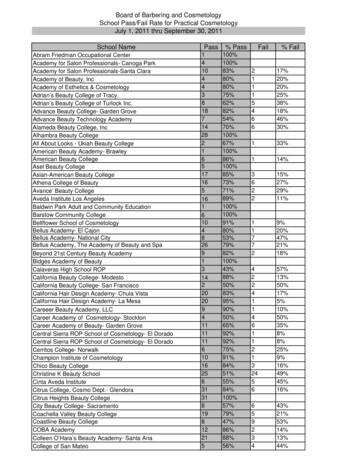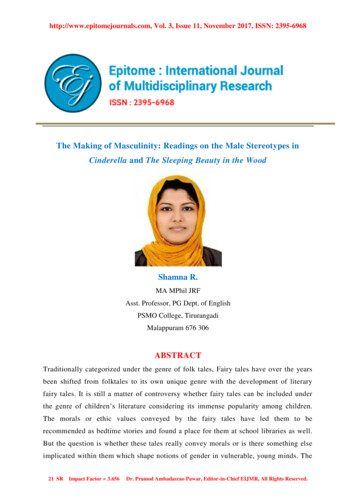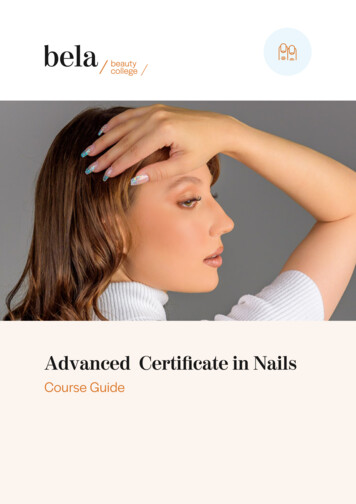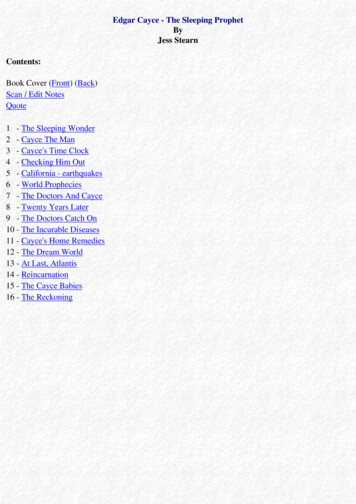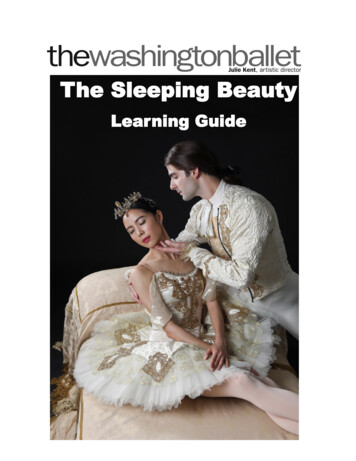
Transcription
The Sleeping BeautyLearning Guide
The Sleeping Beauty Learning GuideCreated by Vanessa Hope, Director of Community Engagement This guide is designed to help you:Introduce the story and artistry of The Sleeping Beauty to students.Explore the art of classical ballet in a fun an engaging way.Prepare students to see a live Ballet and reflect on the performance.Table of ContentsThe Sleeping BeautyPlot Synopsis .3Characters .4-5Creators . .6What is Classical Ballet? .7Learning ActivitiesExploring Fairy Tales . 8Writing Prompts .8Research Project .8Music and Movement 9Recommended Books .10Common Core & National Arts Standards of Learning . .10Community Engagement MissionIntrinsic to The Washington Ballet’s mission to bring the joy and artistry of dance to thenation’s capital, our community engagement programs provide a variety of opportunities toconnect children and adults of all ages, abilities and backgrounds to the art of dance. Throughlive performances, audience enrichment programs, the highest caliber of dance training andeducational events, we aspire to spark and enhance a love for dance, celebrate our historyand cultural diversity and enrich the lives of our community members.To learn more visit: https://www.washingtonballet.orgThe Washington Ballet’s Community Engagement programs are supported by:DC Commission on the Arts and HumanitiesJohn Edward Fowler Memorial FoundationHoward and Geraldine Polinger Family FoundationGEICOThe J. Willard and Alice S. Marriott FoundationThe Harman Family FoundationThe Morningstar FoundationPublic Welfare FoundationBarbara Epstein FoundationBetty and Wes Foster Family FoundationGeorge Preston Marshall FoundationCapitol Hill Community FoundationLorraine S. Dreyfuss Theatre Education Foundation2
The Sleeping Beauty BalletSYNOPSISThe Prologue—an introductory section of a literary or musical workKing Florestan and his Queen have invited all the Fairies to attend the christening oftheir beloved only child, the Princess Aurora. As Aurora ’s godmothers, they presenttheir gifts. Unfortunately no one has remembered to invite the ill -natured Fairy Carabosse. She arrives in a fury and, presenting a spindle as her gift, foretells that Aurorawill one day prick her finger and die. The whole court is in despair, but happily the LilacFairy has not yet bestowed her gift. Though she cannot remove Carabosse ’s curse, shecan change it. Princess Aurora will not die. Instead she will sleep for a hundred yearsand then be awakened by the kiss of a handsome prince.Act I—The SpellIt is the celebration of Princess Aurora ’s sixteenth birthday and Princes from the fourcorners of the world have come hoping to win her hand. A nurse approaches and givesAurora a small bouquet of flowers. As she dances around, Aurora throws the flowers toher friends and pricks her finger on the spindle concealed in the bouquet. Everyone isaghast as Aurora falls, apparently lifeless. The nurse reveals herself as Carabosse andvanishes. Now the Lilac Fair y appears and casts aspell so that the whole court falls asleep while a magicforest grows up around the castle to keep it safe for ahundred years.Act II—The VisionIt is a hundred years later and Prince Florimund headsa hunting party. But he has no heart for the sport anddismisses his retinue to meditate alone on his longingfor an ideal love. The Lilac Fair y enters and shows hima vision of Princess Aurora. Enraptured, he begs theFairy to lead him to this beautiful vision and togetherthey travel through changing landscapes and seasonsuntil they reach the hidden castle where he awakensthe Princess Aurora with a kiss. This breaks the spellDancer Misty Copeland performs as the LilacFairy.Photo asby theMarySohlMistyCopelandLilacFairyand causes the defeated Carabosse to disappear forever.Act III The W eddingFairy-tale characters come to the wedding celebrations of the Prince and Aurora. Theypay their respects to the bride and bridegroom, and then the whole assembly joins in ageneral dance. In a final apotheosis, the Lilac Fairy appears to bless the marriage.3
The Sleeping Beauty CharactersThe Washington Ballet Company will perform Act III of The Sleeping Beauty for the studentmatinee. Act III is the wedding celebration of Princess Aurora and Prince Désiré. You willsee many familiar fairy tale characters as wedding guests.The FairiesPrince DésiréPrincess AuroraCarabosse, The Evil Fairy4
The Sleeping Beauty CharactersThe White Cat&Puss in BootsLittle Red Riding Hood&The Gray WolfPrincess Florine&The Blue Bird5
The Sleeping Beauty CreatorsThe original Author— The writer of a literary work.Charles Perrault (1628—1703) A French author who started the literarygenre of fairy tales. A few of his best known fairy tales are Little RedRiding Hood, Puss in Boots and The Sleeping Beauty In The Wood,which he published in 1697. The ballet is based on this version andmany of his fairy tale characters from other stories appear in Act III.The original Choreographer— A person who creates dance compositions by planning andarranging movements and patterns for dances, especially ballets.Marius Peptipa (1818–1910) was one of the most influentialfigures of classical ballet. Petipa was born in Marseilles, France.His father was a dancer, and Petipa began dancing in his father’stravelling company when he nine years old. At the age of 16 hejoined Théâtre Nantes, where he created a number of ballets. Hewent on to work as a dancer throughout France. In 1847 he madehis debut as principal dancer and ballet master of the MariinskyBallet in Russia. He became famous as a choreographer in 1859with his production of The Pharaoh’s Daughter. He went on tochoreograph many world famous ballets that are still performedtoday. Petipa’s ballets were grand spectacles that mademagnificent use of the corps de ballet and placed the lead ballerinacentre stage. The Mariinsky Ballet Company and school became amodel for all ballet around the globe throughout the 20th century.The Composer—A person who writes music.Pyotr Ilyich Tchaikovsky (1840—1893) is one of the mostpopular Russian composers of all time. He lived and composedduring the 19th century which is called the Romantic periodbecause artists, writers and musicians focused on feelings andpassions more than any other theme. It was popular during thistime to compose music that told a story and Tchaikovsky’sballet’s are often called story ballets. Tchaikovsky’scompositions include 11 operas, 3 ballets and over 100 songs.Collaborators—People who work together and cooperate to create a work of art.Tchaikovsky and Peptipa worked very closely to create The Sleeping Beauty Ballet in1890, The Nutcracker in 1892 and Swan Lake in 1895. These ballet’s are some of the bestknown classical ballets in the world.6
What is Classical Ballet?Classical ballet is a system of dancebased on formally specified movementsand positions of the arms, feet, and bodydesigned to enable the dancer to movewith the greatest possible agility, control,speed, lightness, and grace. Movementsare generally graceful and flowing anddancers create defined lines and shapeswith their bodies. Elements of classicalballet technique include dancing from aturned-out position of the legs, pointework, high leg extensions, dynamic turnsand intricate footwork.The Wa shington Ballet ’s Swan Lake Mist y Cop eland andBrook lyn Mack. Phtoto: Theo KossenasClassical ballets usually tell a story and have themes focused on expressing emotions andpassions. They often include a supernatural world of spirits and magicWhat’s the point of pointe shoes?Ballerinas dance on pointe shoes to create an illusion of lightnessand a sense of floating on air.Before pointe shoes were invented, ballerinas were sometimessuspended on wires to allow them to skim the floor on their toes orrise into the air. In the early 1800s, dancers began rising to theirtoes on their own. The first pointe shoes were simply flat slippers,lightly reinforced by the dancer with darning around the toes. Withsuch light support, the earliest pointe work consisted merely ofbrief rises to pointe. Over the course of two centuries of ballerinas,ballet technique and shoemakers innovations have produced themore supportive shoes used today.Pointe shoes provide support while allowing articulation of the foot.Dancer’s have to develop and use their own strength to dance onpointe.Why do ballerinas weartutus?Tutus allow ballerinas to move freely and gracefully onstage, andthey allow the audience to see the artistry of the choreographyand the dancer’s technique. Tutus are complex costumes built sothey will not droop below a dancers waist and to hold their shape,often with 9—12 layers of tulle. There are several variations onthe Classical tutu. One called the pancake tutu is supported by ahoop inside the fabric, and sits on the dancer’s hip. The plattertutu is similar, but it sits on the dancer’s waists instead. One morecalled the powderpuff tutu is light and fluffy, so it doesn’t need ahoop to support itself.The Washington Ballet’s The Nutcracker,Maki Onuki as the Sugar Plum Fairy.Photo: Theo Kossenas7
Classroom ActivitiesWhat is a fair ytale?There are many different kinds of stories. We can sort storiesinto groups or categories with similar characteristics. Thesegroups are called genres of literature. A fairy tale is a fictionalstory with magical beings and can take place in a magical orfaraway land. Fairy tales come from oral tradition and weretold by one generation to the next until someone finally wroteit down. Fairy tales have good and evil characters and usuallyroyalty. Something magical always happens, such as a spell,and during the story a crazy problem has to be solved. Oncethe problem is solved, everyone lives “happily ever after”. Afairy tale often teaches the reader a lesson.Writing Prompts:1) Based on this description, how do we know The Sleeping Beauty is a fairytale?2) The fairies in The Sleeping Beauty give Princess Aurora the gifts of strength, song, honesty,beauty, and wisdom. If you were a fairy invited to the banquet what special gift would you giveto Princess Aurora? Why?3) Fairy tales often begin “Once upon a time, a long time ago.” Imagine what imagine what lifewill be like in the future. Write a story beginning with Sleeping Beauty waking up 100 years fromtoday. Describe how the world looks different. What is the Prince wearing? Where would thecelebration be? What kind of music and food would be at their wedding celebration?Research & Writing Activity: Cultural PerspectiveThe fairy tale is a literary genre in many different cultures. Two famous storytellers, Jacob andWilhelm Grimm who lived in Germany in the early 1800s wrote the first version of TheSleeping Beauty. If a Native American or a person in ancient Egypt had written a version of TheSleeping Beauty, the setting and characters would probably reflect the people and places mostfamiliar to them. Choose a culture you’d like to learn more about. Research the geography,architecture, clothing and customs of that culture. Write a new version of the The SleepingBeauty that is set in that culture. As the storyteller, use words, references and pictures thatwould make sense to children of this culture8
Music & Movement ActivityThe Waltz of The GarlandPytor Tchaikovsy’s most well known melody from The Sleeping Beauty isThe Waltz of the Garland from Act I. It ’s the same melody used in the songOnce Upon A Dream from Disney’s movie version of Sleeping Beauty.1) Have students listen to The Waltz of The Garland by Pytor Tchaikovsky.2) Ask them if they recognize the melody? Have they heard it before?3) Ask student to share how the music makes them feel? What emotions do theythink the music is trying to convey?4) Have students move around the room to the music.5) How did the music make you want to move?9
Recommended BooksThe Sleeping Beauty: My First Ballet Book, by Jennifer AdamsElla Bella Ballerina and The Sleeping Beauty, by James MayhewThe Sleeping Beauty, by New York City BalletThe Story Orchestra: The Sleeping Beauty, by Katy FlintA Coloring Book of the Sleeping Beauty Ballet, by Laurence SenelickBehind the Scenes at the Ballet: Rehearsing and PerformingThe Sleeping Beauty, by Leslie E. SpattThe Sleeping Beauty Ballet Theatre by Jean Mahoney and Viola Anne SeddonCommon Core ELA-Literacy Standards 6th – 8th GradeWrite arguments to support claims with clear reasons and relevant evidence.Write narratives to develop real or imagined experiences or events using effective technique, relevantdescriptive details, and well-structured event sequences.Engage and orient the reader by establishing a context and introducing a narrator and/or characters;organize an event sequence that unfolds naturally and logically.Produce clear and coherent writing in which the development, organization, and style are appropriate totask, purpose, and audience.Conduct short research projects to answer a question, drawing on several sources and refocusing theinquiry when appropriate.Gather relevant information from multiple print and digital sources; assess the credibility of eachsource; and quote or paraphrase the data and conclusions of others while avoiding plagiarism andproviding basic bibliographic information for sources.Draw evidence from literary or informational texts to support analysis, reflection, and research.National Arts StandardsAnchor Standard 7: Perceive and analyze artistic work.Anchor Standard 8: Interpret intent and meaning in artistic work.Anchor Standard 9: Apply criteria to evaluate artistic work.Anchor Standard 10: Synthesize and relate knowledge and personal experiences to make art.Anchor Standard 11: Relate artistic ideas and works with societal, cultural, and historical context todeepen understanding.10
The Sleeping Beauty Learning Guide Created by Vanessa Hope, Director of Community Engagement This guide is designed to help you: Introduce the story and artistry of The Sleeping Beauty to students. Explore the art of classical ballet in a fun an engaging way. Prepare students to see a live Ballet and reflect on the performance.




